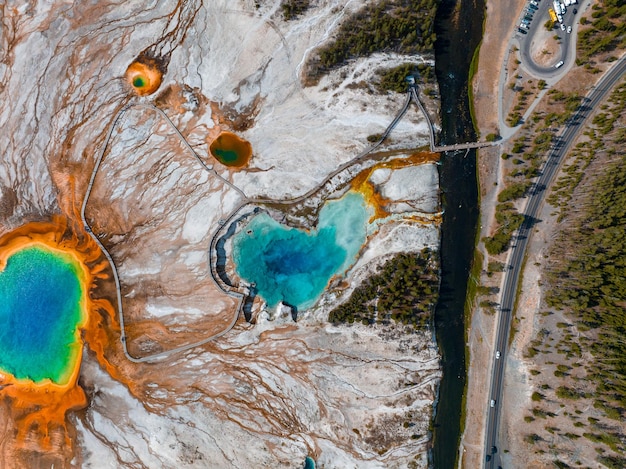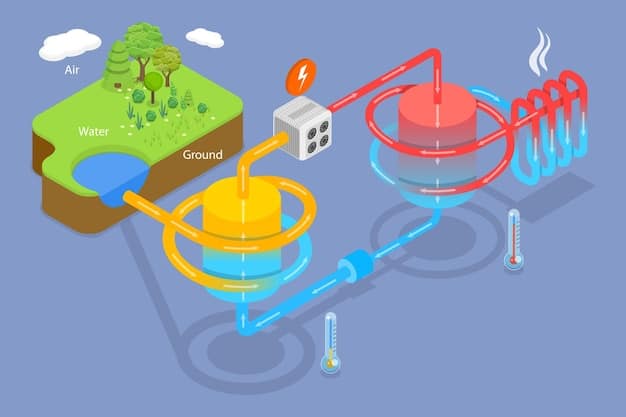The Future of Geothermal Energy in the US: EGS by 2030

The Future of Geothermal Energy in the US: Exploring Enhanced Geothermal Systems (EGS) by 2030 envisions a significant expansion of geothermal power generation through innovative technologies that unlock previously inaccessible geothermal resources, contributing substantially to clean energy goals.
The urgency of climate change has fueled a growing interest in renewable energy sources, positioning geothermal energy as a key player in America’s sustainable future. Exploring the future of geothermal energy in the US: exploring Enhanced Geothermal Systems (EGS) by 2030, this article investigates the potential of Enhanced Geothermal Systems (EGS) to revolutionize geothermal energy production, ensuring a cleaner and more secure energy landscape for generations to come.
Understanding Geothermal Energy and Its Current State in the US
Geothermal energy, harnessed from the Earth’s internal heat, offers a consistent and reliable energy source, unlike some other renewables. Currently, geothermal power plants in states such as California, Nevada, and Utah provide a stable baseload power, but the full potential of geothermal remains largely untapped.
Traditional Geothermal Systems
Traditional geothermal systems rely on naturally occurring hydrothermal resources, where hot water and steam are close to the Earth’s surface. These resources are typically found in areas with high volcanic activity or tectonic movement.
- Direct Use: Utilizing hot water directly for heating buildings, greenhouses, and aquaculture facilities.
- Geothermal Power Plants: Tapping into steam or hot water to drive turbines that generate electricity.
- Limitations: Dependence on specific geological conditions restricts geothermal development to certain regions.
The current geothermal energy landscape in the US is dominated by these traditional systems, but their geographical limitations necessitate exploring other options to broaden geothermal energy’s contribution to the nation’s energy mix.
In summary, while traditional geothermal systems have proven effective, expanding geothermal’s influence requires embracing innovative approaches like Enhanced Geothermal Systems to access a broader range of resources and locations.

What are Enhanced Geothermal Systems (EGS)?
Enhanced Geothermal Systems (EGS) represent a groundbreaking approach to geothermal energy, moving beyond the constraints of naturally occurring hydrothermal resources. EGS technology allows us to access geothermal energy in areas where the rock is hot, but lacks water and permeability.
How EGS Works
EGS involves injecting high-pressure water into hot, dry rocks deep underground. This process creates fractures, forming a reservoir that allows water to circulate and heat up. The hot water is then extracted through another well and used to generate electricity.
According to the U.S. Department of Energy, EGS could potentially provide over 100 GWe of electricity in the United States alone. This significant potential stems from the widespread availability of hot, dry rocks beneath the Earth’s surface.
In essence, EGS is a game-changer because it unlocks geothermal energy in previously inaccessible locations, offering a pathway to significantly increase geothermal’s share in the US energy portfolio.
The Potential of EGS by 2030
By 2030, Enhanced Geothermal Systems (EGS) have the potential to transform the geothermal energy landscape in the US. With advancements in technology and growing investment, EGS could contribute significantly to the nation’s renewable energy goals.
Projected Growth and Impact
Investment in EGS projects is expected to increase significantly over the next decade. This influx of capital will drive innovation and accelerate the deployment of EGS technologies across the country.
- Increased Geothermal Capacity: EGS could add substantial geothermal capacity to the grid, reducing reliance on fossil fuels.
- Economic Benefits: Development of EGS projects will create jobs in construction, engineering, and related industries.
- Energy Independence: Greater reliance on geothermal energy will bolster US energy independence and security.
EGS could lead to the establishment of geothermal power plants in states that previously had limited geothermal activity, diversifying the energy mix and reducing carbon emissions.
In conclusion, the projected growth and impact of EGS by 2030 highlight its potential to revolutionize geothermal energy in the US, offering a cleaner and more sustainable energy source for the future.
Technological Advancements Driving EGS Development
Several technological advancements are crucial for driving the development and widespread adoption of Enhanced Geothermal Systems (EGS). These innovations are improving the efficiency, cost-effectiveness, and environmental sustainability of EGS projects.
Key Innovations
Advancements in drilling techniques, reservoir characterization, and energy extraction methods are pivotal for EGS development. These innovations allow for more efficient and effective utilization of geothermal resources.
- Advanced Drilling: Techniques like horizontal drilling and closed-loop systems are enhancing reservoir access and energy extraction.
- Reservoir Characterization: Improved methods for mapping and monitoring underground reservoirs optimize water circulation and heat extraction.
- Energy Conversion: Enhanced energy conversion technologies, such as advanced binary power plants, improve the efficiency of electricity generation.
These technological innovations are making EGS more economically viable and environmentally friendly, paving the way for widespread deployment across the US.
Therefore, continued investment in these key technological areas will be essential to unlock the full potential of EGS and transform geothermal energy production in the US by 2030.

Challenges and Opportunities for EGS Implementation
While Enhanced Geothermal Systems (EGS) hold immense potential, their implementation faces several challenges. Addressing these challenges while capitalizing on the opportunities is vital for the successful deployment of EGS by 2030.
Overcoming Obstacles
High upfront costs, technological hurdles, and regulatory uncertainties are among the primary challenges for EGS implementation. Overcoming these obstacles requires concerted efforts from government, industry, and research institutions.
Government incentives, such as tax credits and grants, can help reduce the financial burden of EGS projects, making them more attractive to investors.
Addressing public concerns about induced seismicity through robust monitoring and mitigation strategies is essential to maintain community support for EGS projects.
Despite these challenges, EGS offers numerous opportunities, including tapping into vast geothermal resources, creating jobs, and enhancing energy security.
Ultimately, strategic planning, technological innovation, and stakeholder engagement will be crucial to overcome the challenges and seize the opportunities for EGS implementation in the US.
Policy and Investment Landscape for EGS in the US
The policy and investment landscape plays a crucial role in shaping the future of Enhanced Geothermal Systems (EGS) in the US. Supportive policies and strategic investments are essential to accelerate the development and deployment of EGS technologies.
Government Support and Incentives
Government initiatives, such as tax credits, grants, and loan guarantees, can incentivize private sector investment in EGS projects. These policies help reduce financial risks and make EGS more competitive with other energy sources.
The U.S. Department of Energy (DOE) has been instrumental in funding EGS research, development, and demonstration projects, fostering innovation and technological advancements.
Collaboration between government agencies, research institutions, and industry stakeholders is vital to create a favorable policy and investment environment for EGS.
Creating a supportive and incentivizing environment is key to attract investment and drive the growth of EGS in the US, positioning geothermal energy as a significant player in the nation’s energy future.
| Key Point | Brief Description |
|---|---|
| 🌍 EGS Potential | Unlock geothermal energy almost anywhere. |
| 🛠️ Tech Advances | Advanced drilling makes EGS more viable. |
| 💰 Investment | Government and private funding fuel EGS growth. |
| 🌱 Clean Energy | EGS contributes to cleaner energy goals. |
Frequently Asked Questions About EGS
▼
EGS is a method to produce geothermal energy in areas lacking natural water and permeability. It involves creating fractures in hot, dry rocks deep underground by injecting high-pressure water to create a geothermal reservoir.
▼
Unlike conventional geothermal plants limited to areas with natural hydrothermal resources, EGS can be implemented in a wider range of locations where hot, dry rocks are present, significantly increasing the accessibility of geothermal energy.
▼
Key challenges include high upfront costs, the need for advanced drilling and reservoir characterization technologies, and addressing concerns related to induced seismicity. Government support and continuous innovation are vital.
▼
Traditional geothermal taps into natural hydrothermal resources with hot water and steam. EGS, on the other hand, creates its own reservoirs by fracturing hot, dry rocks, making geothermal energy accessible in more locations.
▼
EGS offers the potential to significantly increase geothermal’s role in the US energy grid. It could contribute to a more diversified, reliable, and sustainable energy supply, reducing reliance on fossil fuels and enhancing energy security.
Conclusion
In conclusion, the future of geothermal energy in the US: exploring Enhanced Geothermal Systems (EGS) by 2030 represents a significant opportunity to harness clean, sustainable energy. By overcoming the challenges and capitalizing on technological advancements, EGS can transform the US energy landscape, contributing to a greener and more secure future.




